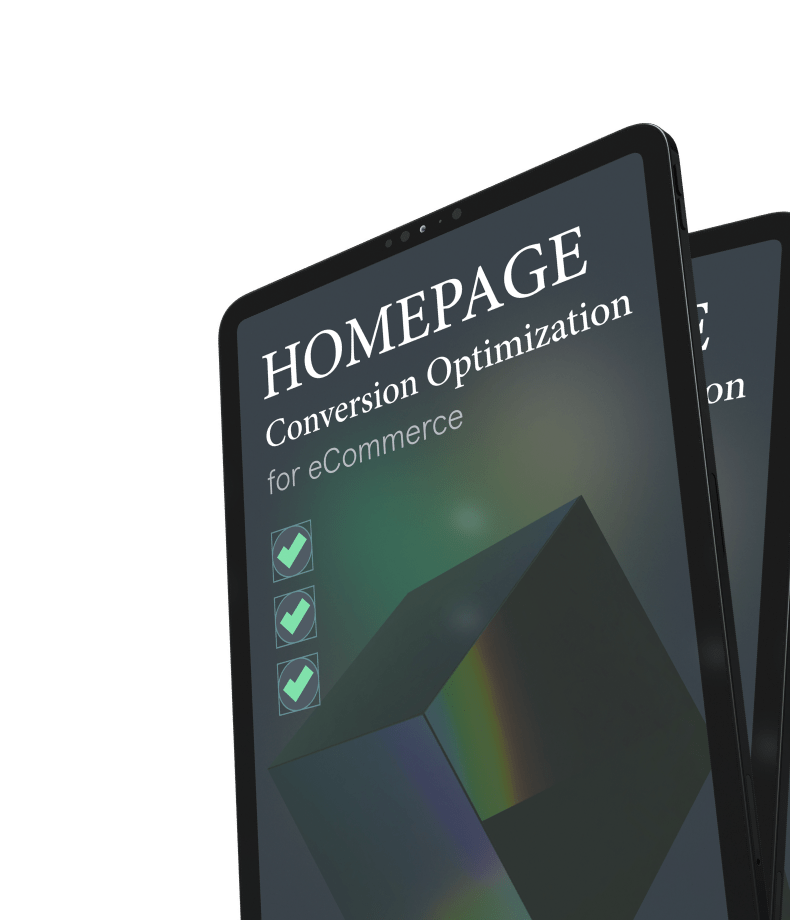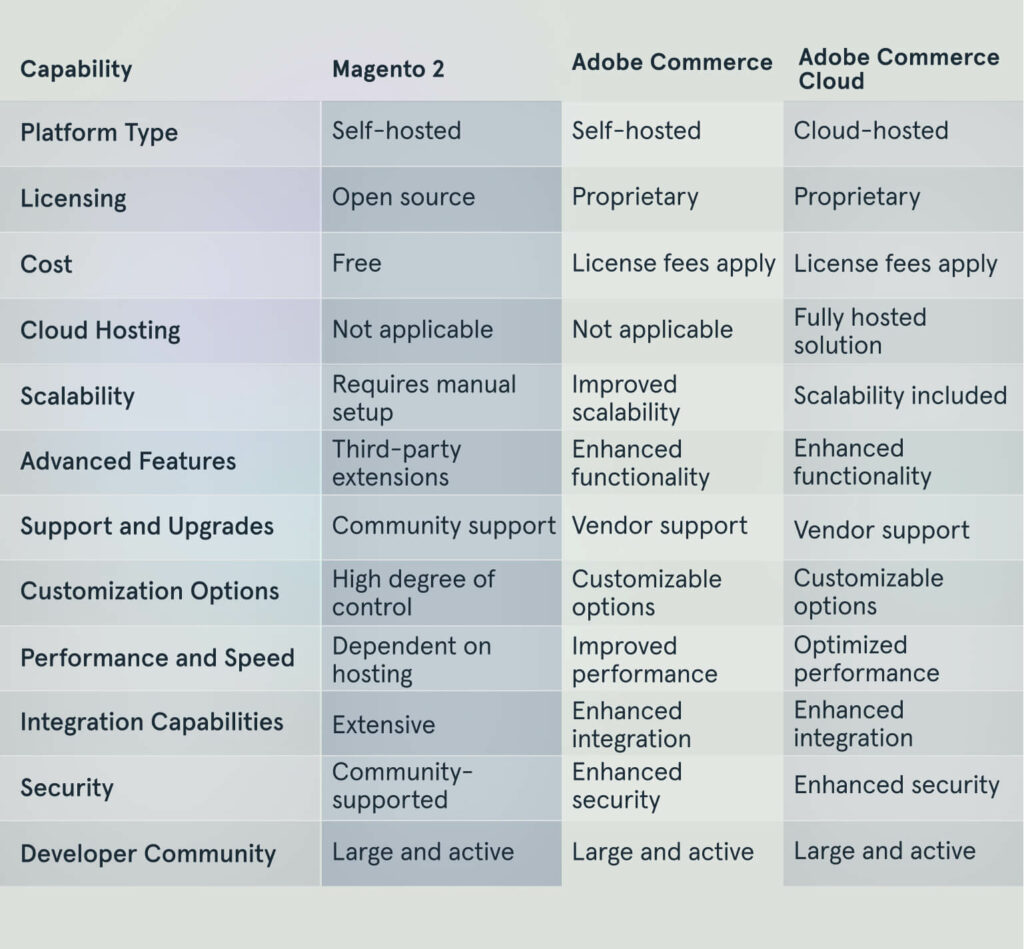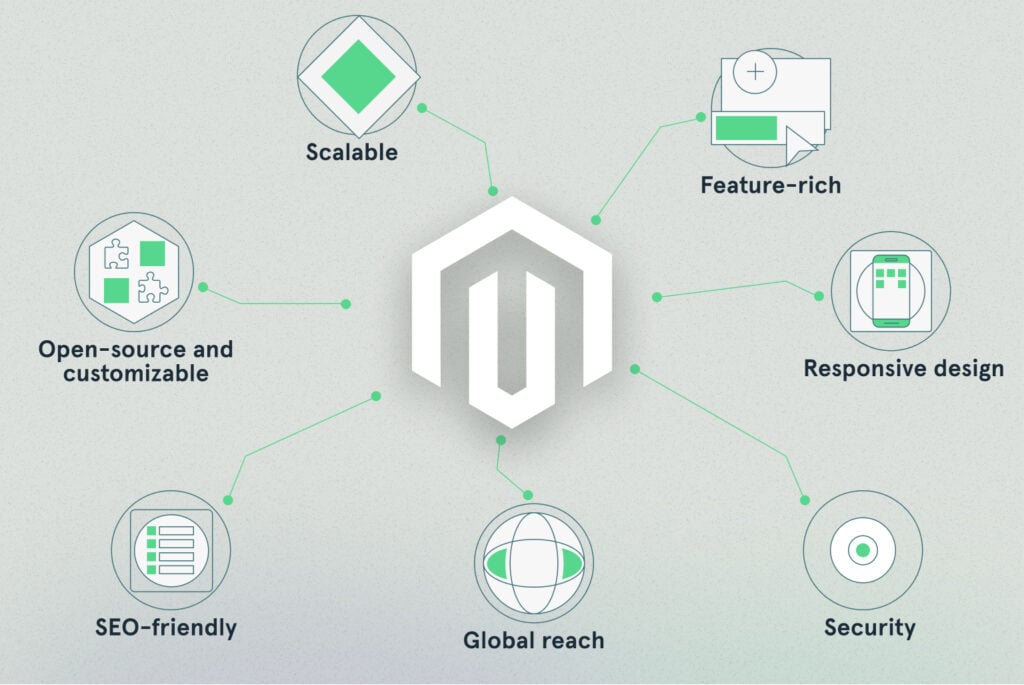That's where Magento comes in, a powerful eCommerce platform that can help your business thrive in the 8.1 trillion dollar market.
Are you an eCommerce business owner looking to build an eCommerce store with Magento?
We've got you covered.
In this comprehensive guide, we’ll take you on a journey through the world of Magento, from planning and installation to optimization and marketing. By the end of this article, you’ll be eager to bring your online store to life.
You’ll learn about Magento versions, features, and benefits:
- How to choose the right platform version for your Magento eCommerce website
- Key reasons why companies choose Magento 2
- How to build a Magento website for a small business
- The process of creating an eCommerce website with Magento
- Magento 2 website development cost
- 16 steps to build a successful online store
- Key considerations when choosing the best Magento website development company
Let’s jump right in!
Understanding Magento Editions
Magento is a powerful open-source eCommerce platform that offers a wealth of features, flexibility, and scalability for businesses of all sizes. Over 250,000 merchants use it for their eCommerce businesses. With its rich set of built-in tools, you can create an online store that looks great and performs well.
Since the choice of an eCommerce solution will directly influence your business, you need to make a data-driven decision.
Magento is distributed in three platform versions designed for different eCommerce businesses.
- Magento Open Source – this is a free Magento edition, which is used by the majority of companies. You don’t need to pay for the use of this version of the platform and need to only take care of hosting, installation process and development costs. Even such a big name as Christian Louboutin doesn’t shy away from Magento Open Source.
- Adobe Commerce (Magento Commerce) – as compared to the previous option, the Magento Commerce version offers additional features and official Magento support. You still need to find a suitable hosting provider and add the cost of using the platform, starting at $24,000 annually.
- Adobe Commerce Cloud (Magento Commerce Cloud) – this is a cloud-based Magento edition that provides all the features of the previous option. It runs on Amazon Web Services, so you don’t have to pay for hosting additionally. Usually, only enterprise companies choose this option, as its annual use cost starts at $40,000 and can reach up to $300,000.
Overall, if you have a small to medium business, Magento Open Source will meet all your business needs. The platform leaves a lot of space for customizations and offers a high level of flexibility, allowing to add additional features with the help of modules and extensions. On the other hand, Magento Commerce and Magento Commerce Cloud are more suitable for big companies that can afford to spend thousands of dollars on extra features and need tools specific to B2B eCommerce.
Why Create an Online Store with Magento: Features and Benefits
Magento has become one of the most popular eCommerce platforms worldwide, and for a good reason. Its robust features, flexibility, and scalability make it an ideal choice for businesses of all sizes. In this section, we’ll explore Magento’s main features and benefits that make it the go-to platform for successful eCommerce businesses.
- Open-source and customizable
Magento is an open-source platform, which means you can access its source code, allowing for endless customization and adaptability. This flexibility enables you to create an online store tailored to your needs and preferences. Furthermore, Magento’s vast developer community continuously contributes to its improvement, ensuring the platform stays up-to-date with eCommerce trends and technologies.
- Scalable
Whether you’re just starting out or already running a large eCommerce business, Magento can scale with you. Its robust architecture supports businesses of all sizes, handling thousands of products and customers without sacrificing performance. As your business grows, you can expand your Magento store without worrying about outgrowing your eCommerce platform.
- Feature-rich
Magento has many built-in features to make managing your online store more straightforward and efficient. Magento has everything you need to run a successful eCommerce business, from product and inventory management to order processing and shipping. Its extensive library of extensions also allows you to enhance your store’s functionality further, adding new features as needed.
- SEO-friendly
Search engine optimization (SEO) is essential for driving organic traffic to your online store, and Magento is built with SEO in mind. The platform offers a variety of built-in SEO tools, such as SEO-friendly URLs, meta tags, and sitemaps. Furthermore, Magento’s architecture is designed to support fast-loading pages, another critical factor for search engine rankings.
- Multi-store management
One of the standout features of Magento is its ability to manage multiple stores from a single admin panel. This means that if you have different brands, product lines, or languages, you can easily manage them all within the same Magento installation. This centralized management simplifies your workflow and makes it easier to expand your eCommerce business.
- Responsive design
With the rise of mobile shopping, having a responsive website is crucial for your eCommerce success. Magento supports responsive design out-of-the-box, ensuring your online store looks and performs well on all devices, including smartphones and tablets. This adaptability leads to a seamless shopping experience for your customers, regardless of their device.
- Global reach
Magento has built-in multilingual and multi-currency support, making it an ideal choice for businesses looking to expand their reach globally. The platform supports multiple languages, currencies, and tax rates, allowing you to cater to customers from different countries and regions with ease.
- Security
eCommerce security is critical for maintaining customer trust and protecting sensitive data. Magento takes security seriously, offering features such as built-in security patches, support for SSL certificates, and two-factor authentication. Additionally, the platform undergoes regular security audits to ensure that it remains safe and secure.
Magento’s powerful features, flexibility, and scalability make it the ideal platform for building an online store that meets your unique needs and supports your business’s growth. By choosing Magento, you’re setting your eCommerce store up for success and ensuring a seamless, enjoyable shopping experience for your customers.
Magento
Development Get an online store that sells. Woo customers with a seamless UX that guides them from the first point of contact to the checkout page.

How to Build a Magento Website: Step-by-Step Process
Embarking on the journey of building a Magento website can be both exciting and daunting. With its extensive features and customization possibilities, it’s essential to understand the steps involved in creating a successful online store.
In this section of our comprehensive guide, we’ll walk you through building a Magento website, from planning and Magento installation to customization and optimization.
So, let’s dive in and start building your Magento website!
-
Planning Your Magento Website
Before diving into the technical aspects of building a Magento website, planning is essential. Start by defining your eCommerce goals, identifying your target audience, and developing a budget. This planning phase will ensure that your Magento store is tailored to your needs and set you up for success.
-
Choosing the Right Magento Hosting Provider
A reliable hosting provider is crucial to the performance and security of your Magento website. Consider shared hosting for smaller stores or dedicated hosting for larger, more resource-intensive websites. Before you start your search, check out Magento 2 system requirements to understand what powers you need to install Magento and for its proper work.
Some top Magento hosting providers include Digital Ocean, Nexcess, Google Cloud, and AWS. When choosing a hosting provider, factors include uptime, speed, and support.
-
Selecting a Domain Name
Your domain name is the first impression of your eCommerce store. Choose a strong, memorable domain name that represents your brand and is easy to spell. Once you’ve selected the perfect domain, register it with a domain registrar like GoDaddy or Namecheap.
-
Installing Magento
With your hosting and domain in place, it’s time to install Magento. Ensure your hosting environment meets Magento requirements, such as PHP version and memory limit. Follow the step-by-step installation guide provided by Magento, and don’t hesitate to seek help from our experts if you encounter any issues.
-
Selecting a Magento Theme
A visually appealing design is key to keeping visitors engaged with your website. Choose from a vast array of free and paid themes to find one that suits your industry and brand. When selecting a theme, consider factors like responsiveness, customizability, and speed.
You can find dozens of themes on Magento Marketplace, for like a hundred dollars. You can also look for such themes online and find individual developers who offer them.
-
Customizing Your Magento Theme
Once you’ve chosen a theme, it’s time to make it your own. Modify theme settings, edit CSS and HTML files, and create a child theme if necessary. Customizing your theme allows you to create a unique look and feel for your webstore that sets you apart from the competition.
-
Configuring Magento Store Setup and Settings
Next, configure your Magento store’s settings, such as general information, payment gateways, and shipping methods. These configurations ensure a smooth customer shopping experience and efficient order processing for your business.
-
Adding Products to Your Store
Populate your store with products by creating categories, adding product attributes, and setting up product variations. Magento’s flexible product management system allows you to showcase your products in the best possible light, making it easy for customers to find what they’re looking for and encouraging them to make a purchase.
-
Managing Your Store
Efficient store management is essential for a successful eCommerce business. Magento makes it easy to manage orders, inventory, and customers from a single dashboard, streamlining your daily operations and saving you time.
-
Implementing SEO Best Practices
Optimize your website for search engines to attract organic traffic and boost sales. Create SEO-friendly URLs, optimize product pages with keywords and relevant content, and utilize Magento’s built-in SEO tools to climb the search engine rankings.
-
Extending Magento Functionality with Extensions
Magento’s extensive library of extensions allows you to add new features and improve your store’s functionality. From payment gateways to marketing tools, there’s an extension for almost every need. Be sure to choose reputable extensions and keep them updated for optimal performance and security.
-
Enhancing Website Security
eCommerce security is critical to protect your customers’ data and maintain their trust. Implement Magento security best practices, such as using strong passwords, updating your software regularly, and installing SSL certificates to keep your online store safe and secure. You shouldn’t have any problems configuring it if you choose among reliable hosting providers.
-
Optimizing Your Magento for Performance
A fast-loading website is vital for customer satisfaction and conversion rates. Optimize your Magento store’s performance by implementing caching, minimizing image sizes, and using performance optimization tools to monitor and improve your site’s speed.
-
Marketing Your Webstore
Promote your store through email marketing, social media, and search engine marketing (SEM) to drive traffic and increase sales. Experiment with different strategies and channels to find the most effective methods for your target audience.
-
Analyzing Your Magento Store’s Performance
Track your online store’s performance using Google Analytics and Magento’s reporting features. Monitoring key performance indicators (KPIs) will help you identify areas for improvement and make data-driven decisions to grow your business.
-
Maintaining your Store
Regular maintenance is essential to keep your eCommerce website running smoothly and securely. Update your Magento core and extensions, troubleshoot common issues, and seek professional help when needed.
Development Get a robust PWA
Supercharge your eCommerce efforts with superb UX and ‘superfast’ speed. Build an eCommerce PWA from scratch or save time and money using GoPWA Storefront.

How to Choose the Best Company to Build an eCommerce Store on Magento
Finding the right company to build your Magento website is crucial for ensuring the success of your eCommerce business. With so many agencies and developers offering Magento development services, it can be challenging to determine which one is the best fit for your needs. In this section, we’ll outline some key factors to consider when selecting a Magento development company to help you make an informed decision.
- Experience and expertise
When it comes to Magento development, experience matters. Look for a company with a proven track record of building successful Magento websites. Check their portfolio to see if they’ve worked on projects similar to yours and if they have experience with the specific Magento edition you plan to use (Open Source or Commerce). It’s also important to verify their expertise in key areas such as design, customization, and optimization.
- Certified developers
Magento certifications are a reliable indicator of a developer’s skill level and knowledge of the platform. Choose a company with certified Magento developers on their team to ensure your project is in capable hands. Certified developers have undergone rigorous training and testing, proving their competence in various aspects of Magento development.
- Communication and project management
Effective communication is essential for a successful development project. The company you choose should be responsive, transparent, and easy to communicate with. Ask about their project management processes and tools, and ensure they have a clear understanding of your requirements and expectations. Regular progress updates and open communication channels will help ensure a smooth development process.
- Client testimonials and reviews
Client feedback is a valuable resource when evaluating a Magento development company. Look for testimonials and reviews on their website, as well as on third-party review platforms like Clutch, GoodFirms, or Google. This feedback will provide insight into the company’s strengths and weaknesses, helping you make a more informed decision.
- Customization capabilities
One of the key advantages of Magento is its flexibility and customization options. Choose a development company that can demonstrate their ability to tailor your online store to your unique needs. They should have experience with custom theme development, extension development, and integrations with third-party applications.
- Post-launch support
A good Magento development company will offer post-launch support to ensure your website remains up-to-date, secure, and performing optimally. Ask about their support packages, response times, and the availability of ongoing maintenance and updates. This ongoing partnership will help you navigate any challenges that arise and ensure the long-term success of your eCommerce business.
- Pricing and timeline
Finally, consider the company’s pricing structure and project timeline. Request a detailed proposal outlining the project scope, deliverables, and estimated costs. Keep in mind that while cost is an important factor, the cheapest option may not always be the best choice. Instead, look for a company that offers a competitive price while maintaining a high level of quality and expertise.
By considering these factors and doing thorough research, you’ll be well on your way to finding the perfect Magento development company to bring your eCommerce vision to life. Trusting your eCommerce website to a team of skilled professionals will ensure a successful, smooth, and enjoyable development experience.

Tips to Make an eCommerce Website Successful
After you have created a store, the work is not done. The next step is ensuring that your target audience will find your store and will be willing to buy. Building user-friendly UX and UI design, utilizing marketing activities, and adding custom features to the store are some of the ways to improve the chances to convert customers.
Let’s take a closer look at what you can do before and after you build a Magento website.
- Conduct competitor analysis
Knowing your competitors will help you better understand how to approach the process of building a Magento store. After you know which products and services you are going to sell, identify which stores offer the same products and which are your competitors. Only after this step, you can move on to Magento website development.
- Plan and fulfill a marketing strategy
Marketing is an integral part of any business, as knowing how to build a Magento website is not enough. You will need to place your store in the spotlight of customers’ attention. You should start working on marketing strategy before you even start looking for Magento development companies. Paid ads, SMM, search engine optimization will help with the task.
- Connect with your shoppers
After you have the website up and running, the job is not done. You can utilize the power of social proof and invite shoppers to share customer reviews, opinions about your store, and how it can be improved. Use the data you collect to further finetune your store and add new customized features.
- Take care of mobile optimization
By 2021, mobile eCommerce will be worth $3,56 billion. Market researches leave no doubt that mobile optimization is a must in the modern world. That’s why while you are searching for a development company, you need to make sure that your future technical partner knows how to build a Magento website that will be optimized for mobile. Better yet, consider Magento 2 PWA development that combines both the features of applications and websites.
- Provide advanced navigation
A webstore is useless to visitors if it doesn’t allow them to find products easily. That’s it is important to create robust navigation with multiple attributes that will provide customers with relevant results. You can either pay for custom development of such a module or just get GoMage Advanced Navigation.
- Offer online support
Don’t leave your customers alone in the face of making a choice. Offer online support before and after the purchase. According to ApexChat, live chats increase online leads by an average of 40 percent. As a business owner, you cannot lose such an opportunity to improve your sales.
- Add a simple checkout process
According to the Baymard Institute, the checkout process has a huge impact on customer behavior. Over 21% of US online shoppers have abandoned an order because of a too long or complicated checkout process. The ideal checkout flow should have 7-8 form fields ideally and should not be more than 12-14 form elements if we talk about companies that require more information from customers.
- Provide popular payment options
The availability of payment options directly influences the conversion rate and decreases the checkout abandonment rate. Baymard Institute states that in 6% of cases customers have abandoned their shopping carts because they could not find a preferred payment method. By studying the market and preferences of local customers, you will understand which payment and shipping options to provide on your Magento store.
- Offer incentives
Discounts, special offers, and sales should become your best friends. You can show them in pop-ups, display on banners placed on the home page, send promotional emails, and tell about special offers on social media. Actively reach out to buyers and entice them to make a purchase.
- Continue evolving
Technology and customer preferences change quickly. Therefore, you need to keep evolving and improving your Magento 2 store with new features and solutions. Collect data, analyze it, make data-driven decisions, and translate them into new features and an awesome website.
How Much Does a Magento Website Cost?
The cost to build a Magento website can vary from $10,000 to $500,000. Such a price range depends on features, third-party integrations, modules, customisations, design and its difficulty, branding collaterals, outsourcing location… and the list goes on and on.
How to Build a Magento Website: Key Takeaways
As we reach the conclusion of our comprehensive guide on building a Magento website, let’s recap the essential steps and insights that will set you on the path to eCommerce success. By following these key takeaways, you’ll be well-prepared to embark on your Magento journey and create a thriving online store that captivates your customers.
- Understand the power of Magento: Magento’s open-source nature, robust features, and scalability make it an ideal choice for businesses of all sizes looking to build a successful eCommerce store.
- Plan ahead: Define your eCommerce goals, identify your target audience, and develop a budget to ensure your Magento store is tailored to your specific needs.
- Choose the right hosting and domain: Select a reliable hosting provider and a memorable domain name to create a strong foundation for your Magento website.
- Customize and optimize: Select a visually appealing theme, customize it to suit your brand, and optimize your website for search engines to drive traffic and boost sales.
- Implement best practices: From managing your store efficiently to enhancing security and performance, follow Magento best practices to ensure a seamless and enjoyable shopping experience for your customers.
- Partner with the right development team: Choose a Magento development company with experience, expertise, and a proven track record to bring your eCommerce vision to life.
With these key takeaways in mind, you’re now ready to start your journey towards building a successful Magento website.
As you take these next steps, remember that our expert development team is here to guide you every step of the way. We understand the intricacies of the Magento platform and are committed to helping you create a top-notch online store that drives sales and grows your business.
Don’t hesitate to reach out to our team for all your Magento development needs.
We’re excited to partner with you and support your eCommerce success. Click the button below to get in touch with our development team and take the first step towards building your dream Magento website.









